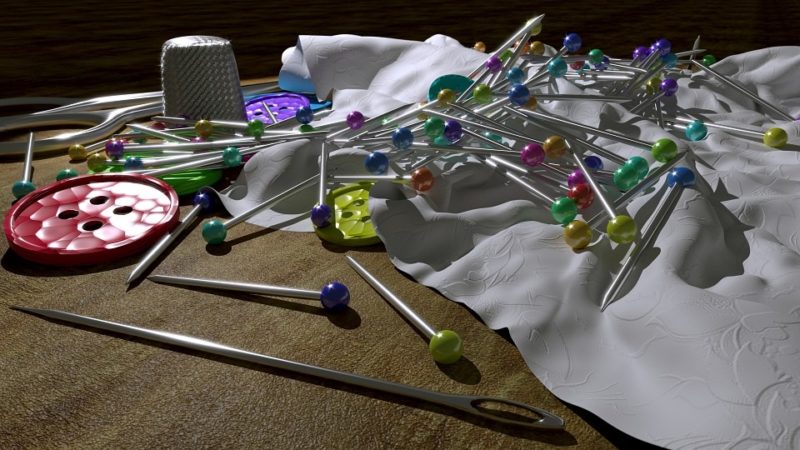The answer to what is baste in sewing is that it’s a temporary stitch. We’ll discuss it in more detail, including the uses below. Are you also interested in other sewing terminologies?
For example, you might be interested in knowing what is interfacing in sewing. It would always be helpful to familiarize yourself with sewing terms, especially as a beginner.

What Does It Mean To Baste In Sewing?
Baste in sewing refers to creating a basting stitch, a temporary or removable stitch for holding several fabric pieces together. You can make these long stitches by hand or with a sewing machine, and some people also call it tacking.
You’ll have an easier time working on the project since it keeps everything from moving. You’re using basting stitches to replace pins, especially when you want to hold multiple layers of material. Furthermore, basting is useful when making garments, especially in the seams because you can test the fit with basting stitches before making permanent stitches.
What Is A Baste Used For?
-
For working with slippery materials
Basting is an easy way to gather and stabilize fabrics like silk and velvet, unlike pins and other ways to bundle the material where it can be challenging since they shift a lot. Also, it can be frustrating to cut or sew these slippery materials, so basting them will be better.
-
For adding trims and zippers
It can be tedious to add ribbons, piping, and zippers to the project because they are flexible. Therefore, you can use basting stitches to keep them steady as you work on the project. You’ll also be able to add the final stitches on them much more comfortably.
-
For challenging edges
You can benefit from basting when gathering the edges of your project. This will ensure a neat finish, especially when you’re adding details such as folds, ruffles, and pleats. But more than these additions, basting is another way to work around cornered or curved edges and seams comfortably.
-
For testing garments
Sewing garments can be challenging because you want the finished project to provide the perfect fit. You can continuously test and fine-tune the clothes by basting before sewing the final seams. You can also use basting as you are constantly altering any piece of wardrobe.
-
For quilting
Quilting can be done with pins, but you can achieve better alignment using basting stitches instead. Some even treat these temporary stitches as decorative details in the entire quilt. And if it’s your first time quilting, you may find it more comfortable to work with basting stitches than pins.
Is Basting A Permanent Stitch?
Basting or tacking is not a permanent stitch. It is meant to be removed eventually, and that’s why basting stitches are loose and longer than permanent stitches. However, there are instances where you can leave the basting stitches on the sewing project.
For example, it can be on quilts or garments where the stitches are left for decorative purposes. On garments, the basting can also be left inside the seam or edges.
What Are Three Types Of Basting?
Uneven, even, and diagonal basting are the three types of basting. In particular, they are the types of hand basting. Machine basting, on the other hand, is another method to make basting stitches.
Uneven basting
Uneven basting is the easiest and most common basting stitch. However, the length and spaces of these stitches are not uniform where the shorter ones are under the material, and the longer ones are at the top.
Even basting
Even basting stitches look uniform and reminiscent of actual running stitches. They are shorter than uneven basting stitches, and the length and spaces are equal on both sides of the material. This type of basting would be the better choice for more challenging projects that need stability.
Diagonal basting
There are also diagonal basting stitches, which from the name itself, are in a diagonal orientation compared to the straight uneven and even basting stitches. However, the stitches are still spaced uniformly and diagonal at the top and horizontal at the bottom. You will use diagonal basting stitches when working on large projects.
How Do You Baste On A Sewing Machine?
- Select the straight stitch setting or basting stitch if your sewing machine has it
- Select the longest stitch length and lower the thread tension for loose stitches that are easier to remove later
- Sew as you normally would, except you don’t backstitch at the beginning and end
- Once done, press up, pull, and cut the thread so you’ll have a loose thread tail that you can pull
If you’re new to using a machine, read about how a sewing machine works to understand its mechanisms.
Conclusion
And that’s it! We discussed what is baste in sewing, and it refers to the temporary basting stitches. They are long and loose and often used to hold the fabric to sew much more manageably.
You can either sew by hand or with a machine. However, if you want to baste faster and more precisely, it’s more convenient to make the basting stitches with the sewing machine. Basting bulkier projects will also be more accessible in the sewing machine, especially when working on commercial sewing projects.
